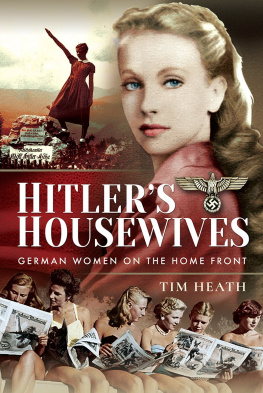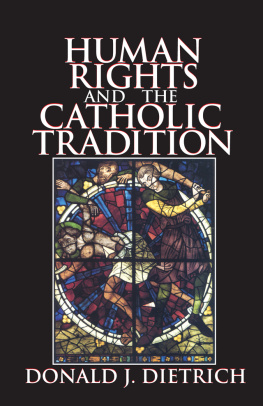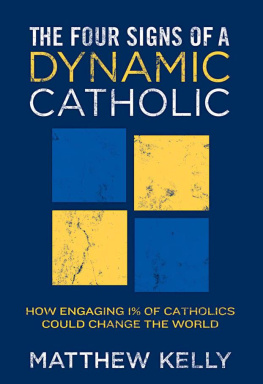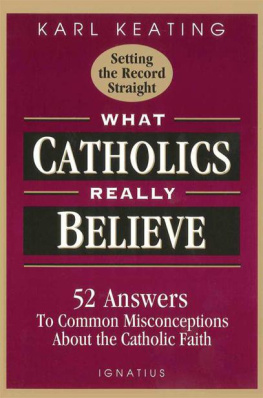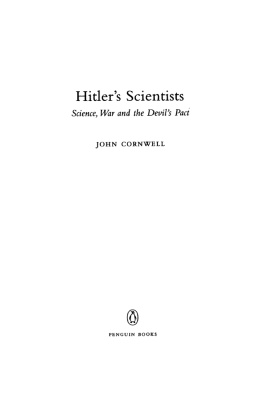University of Notre Dame Press edition 1989
University of Notre Dame
Notre Dame, Indiana 46556
www.undpress.nd.edu
Reprinted in 2002, 2009
Copyright 1962 by Sheed and Ward
Reprinted with permission
Manufactured in the United States of America
Library of Congress Cataloging-in-Publication Data
Zahn, Gordon Charles, 1918
German Catholics and Hitlers wars : a study in social control / by Gordon C. Zahn.
p. cm.
Reprint. Originally published: New York : Sheed and Ward, 1962.
Bibliography: p.
ISBN 13: 978-0-268-01017-1 (pbk.)
ISBN 10: 0-268-01017-X (pbk.)
1. Catholic ChurchGermanyHistory1933-1945. 2. Church and stateGermany1933-1945. 3. World War, 1939-1945Catholic Church. 4. PacifismReligious aspectsCatholic ChurchHistory20th century. 5. National socialism. I. Title.
BX1536.Z3 1989
282'.43dc19
88-23207
ISBN 9780268161705
This book is printed on acid-free paper.
This e-Book was converted from the original source file by a third-party vendor. Readers who notice any formatting, textual, or readability issues are encouraged to contact the publisher at .
Preface
IN 1962 WHEN THE first edition of this book appeared, the research it reported had already been the center of furious controversy for two years and more. A paper presented at the 1959 convention of the American Catholic Sociological Societya paper prepared after this monograph was completed, based on leftover data relating specifically to the wartime German Catholic presshad unleashed a storm of protest in Germany. Before that controversy ran its course it would involve some very high ranking prelates at the Vatican as interested parties. So intense was the opposition that publication of the book, which had been accepted months before, underwent a series of delayed release dates until, finally, the publisher felt obliged to withdraw and turned the manuscript over to Sheed and Ward. The protests, now redirected to them, were effective enough to convince Frank Sheed a personal reading of the galleys was required before the book could be permitted to go to press. The review, I am happy to say, convinced him of its importance and he approved going forward despite whatever risks or protests doing so might entail.
Excerpts from a letter to Dorothy Day, written by a German monsignor who, it was reliably reported, had been specifically commissioned by the hierarchy to protest and rebut my findings, will illustrate the tone of this opposition. The January 1960 issue of The Catholic Worker had included what the monsignor described as an endorsement of my monstrous thesis submitted by some fanatical adepts parrot[ing] the voice of their deceitful master. The convention paper, he insisted, had been written in defiance of basic rules of his [the deceitful masters, that is] profession and in disregard of the historic facts as well as of the simplest laws of honest logic and method. That was bad enough, but the generalizations published in the Workerhe graciously assumed while Dorothy was away from New Yorkwere even more disgusting than the arrogant distortions of the original paper. (The paper itself, incidentally, was subsequently published in a slightly expanded version in Cross Currents.)
The book, when it finally appeared, had a more mixed but generally positive reception. Both favorable and unfavorable reviews, to say the least, were decidedly emphatic. Commonweals reviewer assured prospective readers that [D]iscussions of the problem of the just war will henceforth begin with this book, while Father Robert Graham, S. J., writing in America, described it as an amalgam of strained sociology, seriously defective theological argumentation and pacifist special pleading. The peak of adverse enthusiasm, however, was scaled by The Wanderer in a three-part unsigned diatribe that was subsequently published and given broader circulation as a pamphlet.
So here we are, more than thirty years later, marking the publication of a new edition. It is unlikely in the extreme that there will be a repetition of the controversy stirred by the original. Why then? Bitter though some of the attacks may have been, malice can be dismissed as a dominant factor. In the cold war atmosphere of the late 1950s and early 60s, divided Germany saw itself, with justice, as a contested battleground between the victors. The Eastern zone (today the DDR) was firmly locked into the Soviet sphere, and the territory occupied by the Western powers had become a stronghold of support for U.S. policy and strategy. In the Adenauer years especially, the Catholic Church in Germany was a political force to be reckoned with, totally committed to the new Bonn government. The combination of these two factors assured that anything which threatened to lessen the Churchs influence was likely to be regarded as providing aid and comfort to its enemiesand the enemy both State and Church had in mind was Communism.
One of German Catholicisms most cherished assets in the postwar years was its record of opposition to Nazism. The claim, let it be said at once, was valid: whatever else may be said about that record, there had been opposition and, given the nature of Adolf Hitlers totalitarian state, any opposition required an element of heroism that should not be ignored or denied. Granting this as a fact, however, should not justify exaggerating its extent. For the most part open and official opposition was limited to direct and public violations of Church teachings (denunciations of euthanasia, for example) or direct interference with rights granted the Church under the terms of the 1933 Concordat (closing of seminaries and convents, banning of religious processions, removal of crucifixes from schoolrooms, etc.).
Thus opposition did not extend to equally public protests against Hitlers infamous Final Solution. Here official silence reigned, though many individual Catholics engaged in secret underground efforts to save Jews by spiriting them out of the country and some of these efforts were given deniable support by prominent churchmen like Cardinal Faulhaber. When it came to Nazi Germanys wars of aggression, however, the pattern was one of loyal participation supported and encouraged by episcopal reminders to the Catholic faithful of their duty to serve Folk and Fatherland. These reminders were given added emphasis in the ritual honors dedicated to those who gave their lives in the fulfillment of that duty. That is what this book is about.
If much of the opposition stirred by the questions addressed by my research can be explained in terms of predictable resentment over the destruction of a deeply cherished myth of total opposition, this reaction was intensified by the added element of urgency arising from the political situation at the time. The rearming of the new West German Republic, strongly promoted by its American sponsors, was in full swing, and a crucial part of that program was the proposed restoration of universal military conscription. Many Germans (not to mention its most recent victims) saw this as a threatening reversion to the nations traditional militarism.
To quiet such fears and placate the opposition, the proposed legislation included a generous provision for recognition of conscientious objection. To Germanys Catholics, however, this presented a new problem. The Catholics of the Left (already suspect in the eyes of Church leaders) pressed for the extension of this right to Catholics; to those leaders, supported by prominent theologians, this represented a dangerous deviation from traditional Church teaching. Before it was over the heated debate stirred echoes in Rome when Pope Pius XII, reportedly under the influence of a close German advisor, included what many accepted as a formal condemnation of conscientious objection in his 1956 Christmas message. (Even if that was his intent, the condemnation has since been superceded by later and more official actions taken by Vatican II and his successors.)


